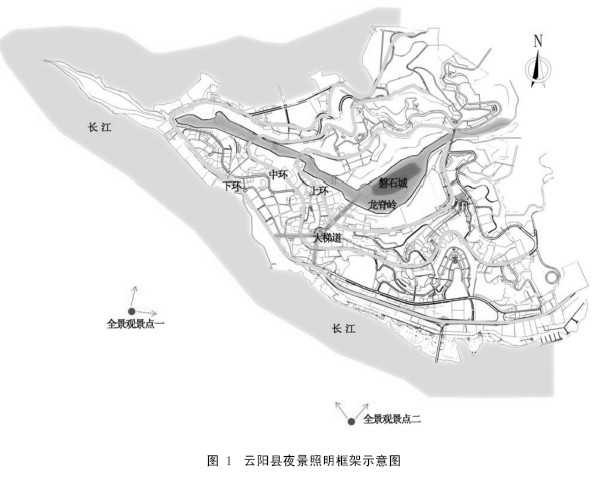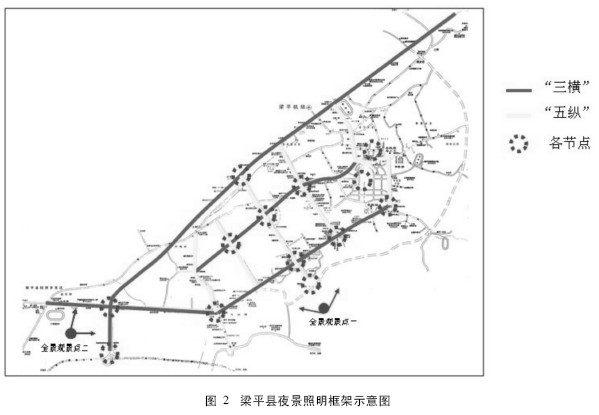introduction 1 Differences between lighting plans for mountainous and plain small and medium-sized cities The main urban area of ​​Yunyang County is backed by Longji Ridge, facing the Yangtze River. The terrain is high in the north and low in the south, showing obvious mountainous landforms. The main roads are ring-shaped, respectively known as Binjiang Avenue, Yunjiang Avenue and Wangjiang Avenue, which are commonly known as the Lower Ring, Central Ring and Sheung Wan! The lower, middle and upper rings form the main skeleton of Yunyang County's traffic. Together with Longji Ridge and Jiangbian, the overall picture is divided into five levels on the facade. Therefore, the basic framework of night lighting in the main urban area of ​​Yunyang County is summarized as two points, three rings, one ridge and one city number node (see Figure 1). Two of them! Refers to the night illumination of two full-view attractions; one ridge! refers to the night illumination of the Longji Ridge of the city skyline; one city! refers to the night illumination of the city that occupies the natural high point and has a certain historical protection value. . The main urban area of ​​Liangping County is dominated by shallow hilly landforms and dams. The roads are in a grid-like layout, showing the characteristics of more plain cities. Different from the typical plain city, the Ziziyan Park and the Shima Park on the edge of the county have a natural terrain and a wide view, overlooking the whole city and becoming a natural panoramic sight. The basic framework is summarized into two points, eight lines, and several nodes! Two of them! Refers to the night illumination of two full-view attractions; Eight Lines! is a summary of the road system three vertical and five horizontal! (see Figure 2). In summary, through field research and analysis, for the mountain-type city representative Yunyang County, Longjiling, the three-ring main road and the river surface, which play an important role in the overall picture level of the night scene, are extracted and summarized as frame elements; The prototype city represents Liangping County, and it focuses on the construction of night scenes on the main roads and buildings along the street to form a certain texture, which constitutes the skeleton of the night scene. 1. 2 Selection of full landscape attractions Regarding the selection of viewpoints, mountain-type cities and peaceful prototype cities also have large differences in lighting planning. In mountainous cities, due to the large fluctuations of the terrain, there are often natural heights or as full-scape attractions of the city; while the latter relies more on high-rise buildings with better locations within the city. In the selection of plain city view points, although there is no natural view point, it has relatively more autonomy and flexibility, and can be selected based on the high-level location and nature. In the lighting planning of Yunyang County, choose Zhang that is separated from the city by the river. The Feimiao Temple and the Yangtze River Bridge Bridgehead serve as two full-view attractions (see Figure 3). The construction of the Zhangfei Temple View Point can attract people at night, accumulate popularity to a certain extent, increase the visibility of the historical attractions, and stimulate the economy.
The landforms in Chongqing are dominated by hills and mountains. The districts and counties under the jurisdiction of the city show the geographical characteristics of mountainous cities. At the same time, the terrain of some areas is relatively flat. For example, the urban area of ​​Liangping County is dominated by shallow hills and flat dams. Geographical features. The mountain-level and plain-type urban night lighting planning is different from the overall planning ideas, the selection of viewpoints, and the building lighting techniques. At the same time, it is limited by many factors such as economic foundation and resource allocation, regardless of mountain type. It is also a plain small and medium-sized city. When planning night lighting, it should promote the development, conservation, and efficiency of the benign circulation rule, so that it can use better investment to achieve better economic and social benefits. By comparing the lighting plans of Yunyang County and Liangping County, the author summarizes the similarities and differences between the two, and further summarizes the problems that should be paid attention to in the lighting planning of small and medium-sized cities.
1. 1 Geographical characteristics of the overall planning framework The geographical characteristics of the city have a great impact on the refinement of the planning framework elements. From the typical method of lighting planning, the topography of mountainous cities is ups and downs, the night lighting planning is mainly based on performance, while the plain city is based on the grid texture of the road; from the refinement of planning framework elements, Compared with the flat prototype city, the mountain and water contours in the mountain-type city may be combined with the road, highlighting the structure of the mountain-type city, enriching the nighttime picture level, and having certain recognizability, while the plain city relies on extraction. Important roads form a certain texture (such as the road structure of Liangping County, three vertical and five horizontal!). Take Yunyang County and Liangping County as examples to introduce the ideas for the development of the overall planning framework for mountainous and plain cities. 

